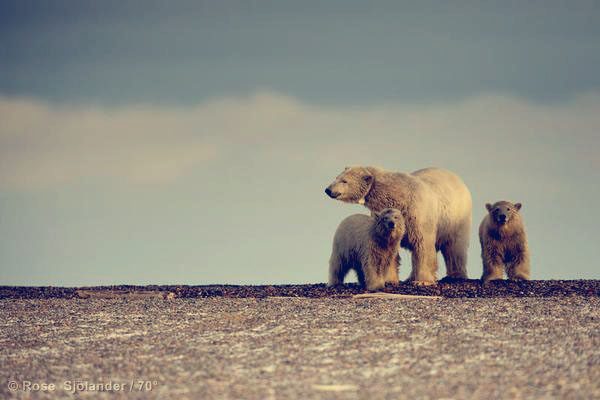
It’s no mystery that polar bears are in trouble. Scientists and experts at a recent international meeting claim that two-thirds of the world’s polar bears will be gone by 2050.
The furry predators have long been viewed as the charismatic mammal of global warming. They are certainly close to the fire experiencing sea ice melt in the Arctic firsthand. Polar bears need a solid ice platform to forage and hunt their main prey, seals. They’ve been experiencing less and less of it every year, and are typically left with thinner ice more prone to melt.
Not only does global warming itself threaten polar bears and their habitat, the entire ecosystem now faces the risk of disastrous oil spills from companies like Shell and Gazprom heading to the Arctic to drill for oil this year.
Their expressive faces are not the only reason scientists and environmentalists dubbed polar bears the spokesanimals of global warming. Read more about why polar bears important and why they’re worth saving (aside from the fact that they’re living creatures with the right to exist, of course).
1. As one of the largest land carnivores in the world along with grizzly bears, polar bears are known as a keystone species, the apex of the ecosystem. They keep biological populations in balance, a critical component to a functioning ecosystem.
2. They’re also a sign of health for the ecosystem. If the keystone species is unhealthy, that’s a sign the entire ecosystem is in trouble. In the case of the Arctic, the health ofthatecosystem is a sign for what’s in store for the rest of the world.
3. Polar bears eat almost exclusively seals, but if they can’t hunt for that food source due to lack of a sturdy ice platform or pure exhaustion, they’ll quickly move on to others. This could threaten the existence of other Arctic species, like the Arctic fox or the walrus, as they compete for food resources.
4. Scavengers like the Arctic fox and Arctic birds like the snowy owl depend on big kills from polar bears as sources for food as well. If they’re not killing seals, they’re cutting outanother food source for wildlife
5. If the population of seals increases without polar bears to control their population numbers , that could threaten the population of crustaceans and fish, an important food source for local human populations as well as other Arctic wildlife.
6. With food sources becoming scarce and the dismantling of the food chain due to the polar bear’s absence, wildlife that doesn’t typically eat vegetation, scarce enough in the Arctic, will start to gobble it all depletingthatfood source for herbivores.
Similar to jaguars, sea otters, the African elephant and wolves, polar bears play an irreplaceable role in the health of the Arctic.

